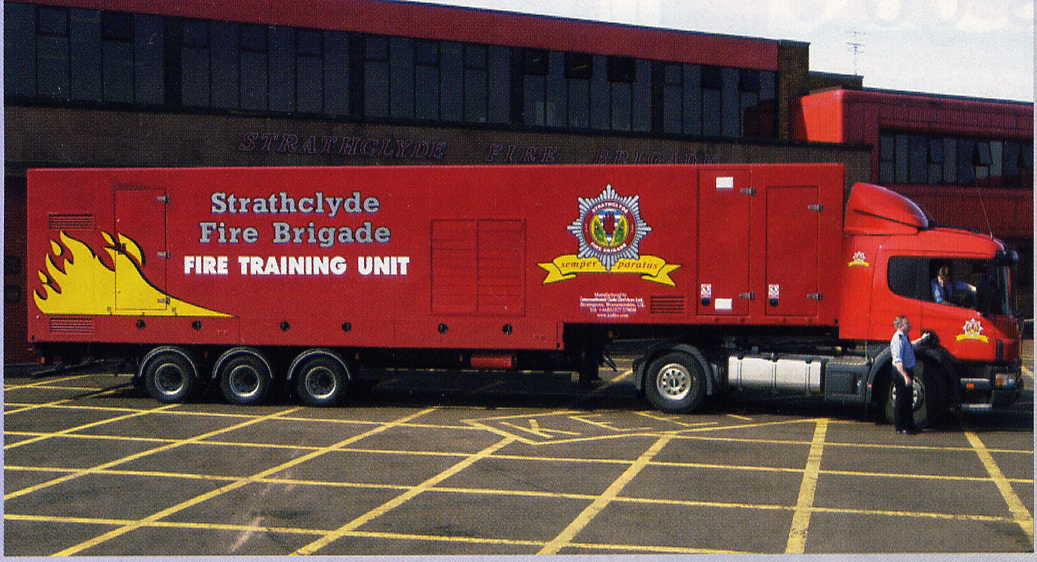
HOT FIRE TRAINING UNIT
The Hot Fire Training Unit is a mobile unit which will be used to train
Retained and Volunteer Units to the same standard as wholetime firefighters (who
will get their training at BTC Cowcaddens). It is a 13.6 metre step frame triple
axle trailer with three compartments, the control room is at the rear above the
propane gas cylinders, then there is the compartment where roof and ground level
flashovers can be simulated, and the front compartment which is a kitchen and
chip pan fires can be simulated. The trailer is towed by a Scania P114L-340
tractor unit.
The unit was supplied by International Code Services of Bromsgrove.
When not out at stations the Unit will probably be kept in the yard at
Cowcaddens.

BX51NMJ Scania P114L-340 + trailer/International Code Services HFTU
2 more Photos of the Hot Fire Training Unit.
Strathclyde's new mobile compartment fire training
Strathclyde Fire Brigade have taken delivery of the first ever articulated mobile fire training unit in the United Kingdom. This unique project was built for the brigade by International Code Services Limited of Bromsgrove, a leading manufacturer and installer of propane fuelled hot fire training systems.
Identified need
The need for such a vehicle had been identified by Firemaster Jeff Ord in his First Impressions, Future Progress report. He went on to say that ‘...the law does not differentiate between wholetime, retained or volunteer firefighters and all should receive the same equipment and training to enable them to carry out their functions efficiently and safely. The safety of our personnel is paramount, those who protect our communities within the remotest parts of the brigade will be well served by the purchase of the mobile fire training unit. This will ensure consistency in the quality and realism of training delivery provided to all frontline personnel and will enable us to take the training to them, rather than them attend the Brigade Training Centre in Glasgow’.
Training compartment
The vehicle itself consists of a Scania P114 tractor unit fitted with an 11.51 Euro 3 engine and a step frame skeletal trailer. The training compartment, comprising a demountable self contained fire training module, is located and locked onto the 13.6m step frame triple axle trailer base.
The gas room is situated at the rear of the vehicle. This room is separated from adjoining rooms by fully welded insulated steel bulkheads. The room accommodates two gas cylinder cassettes each containing four 47kg LPG cylinders and two nitrogen cylinders. Each cassette is manifolded and equipped with quick release couplings which are attached to the main gas supply first stage regulator. The cylinders are stored on a hydraulic hoist to allow for removal and lowering from the vehicle. Gas storage allows 60+ flashovers per cassette. The maximum flashover duration is variable up to 20 seconds maximum.
The Plant Room consists of all the valves required to operate the fireplaces from the main isolation valve to the main fireplace burner gas valves, installed in accordance with EN746 Part II.
Ventilation shaft
The ventilation facility is located between the plant room and the electrical distribution room. It is a shaft made by fully welded insulated steel bulkheads which not only form the shaft but also act as strengthening ribs for both the main fire room bulkhead and the gas room bulkhead.
The safety lynch pins of the ventilation process are:
• Purging
• Dilution to an LEL safety factor of four (or two when continuous monitoring of gas concentration is employed)
• Monitoring gas concentration
• Continuous operation of ventilation fans during training exercises.
Applying these principles to the fire room results in a minimum ventilation rate capable of maintaining a gas concentration below 50% LEL during normal operation stepped up to a 25% LEL rate in the case of abnormal or emergency events. The ICS system allows for a positive proof of ventilation flow. This is achieved by a sensor measuring the air pressure inside the ducting. If the pressure falls outside the ‘operating’ parameters the control system shuts down all gas flows and fires.
Flashover simulation
The fire room consists of bunk bed fire, cooker fire with spill fire capability, which simulates the effect of an oil fire or the chip pan fire boiling over and being ignited on the floor. This fire is also equipped with the necessary control to provide both low and high fires. The flashover/rollover bar simulates a flashover/rollover along the ceiling of the fire room. This ceiling is double skinned 6mm steel with a 50mm gap filled with rock wool slab.
Control room
The control room incorporates the computer touch screen control panel with remote diagnostic assistance. The emergency shutdown/evacuation controls and gas detection monitoring equipment control panels. The temperature monitoring thermocouples, at 1.5—2m above floor level, are located in the fire room and lobby approach. Any unwanted risk in temperature above 150°C will facilitate automatic shut down and ventilation.
The control room allows the operator to:
• Enable fires to operate by initiation of both the instructor and control room operator
• Accept commands to halt or pause the training exercise or commands to abort or shut down training exercises
• Monitor the condition of the overall system particularly safety devices and automatically shuts down or renders safe any equipment that is not operating correctly
• Log and store historical data such as temperature for record purposes
• Access the thermal imaging facilities with video playback. The fire training module and allied equipment conforms to the Fire Service Manual, Volume 4, Fire Service Training, Guidance and Compliance Framework for Compartment Fire Behaviour Training.
International Code Services has provided Strathclyde Fire Brigade with a world class facility that will provide personnel with the capability of achieving the level of emergency, preparedness and skill demanded by the fire service profession.
(Fire Times Volume 4 No.3 April/May 2002. Page 23.)
Article reproduced by permission of David Holden, Editor, Fire Times.